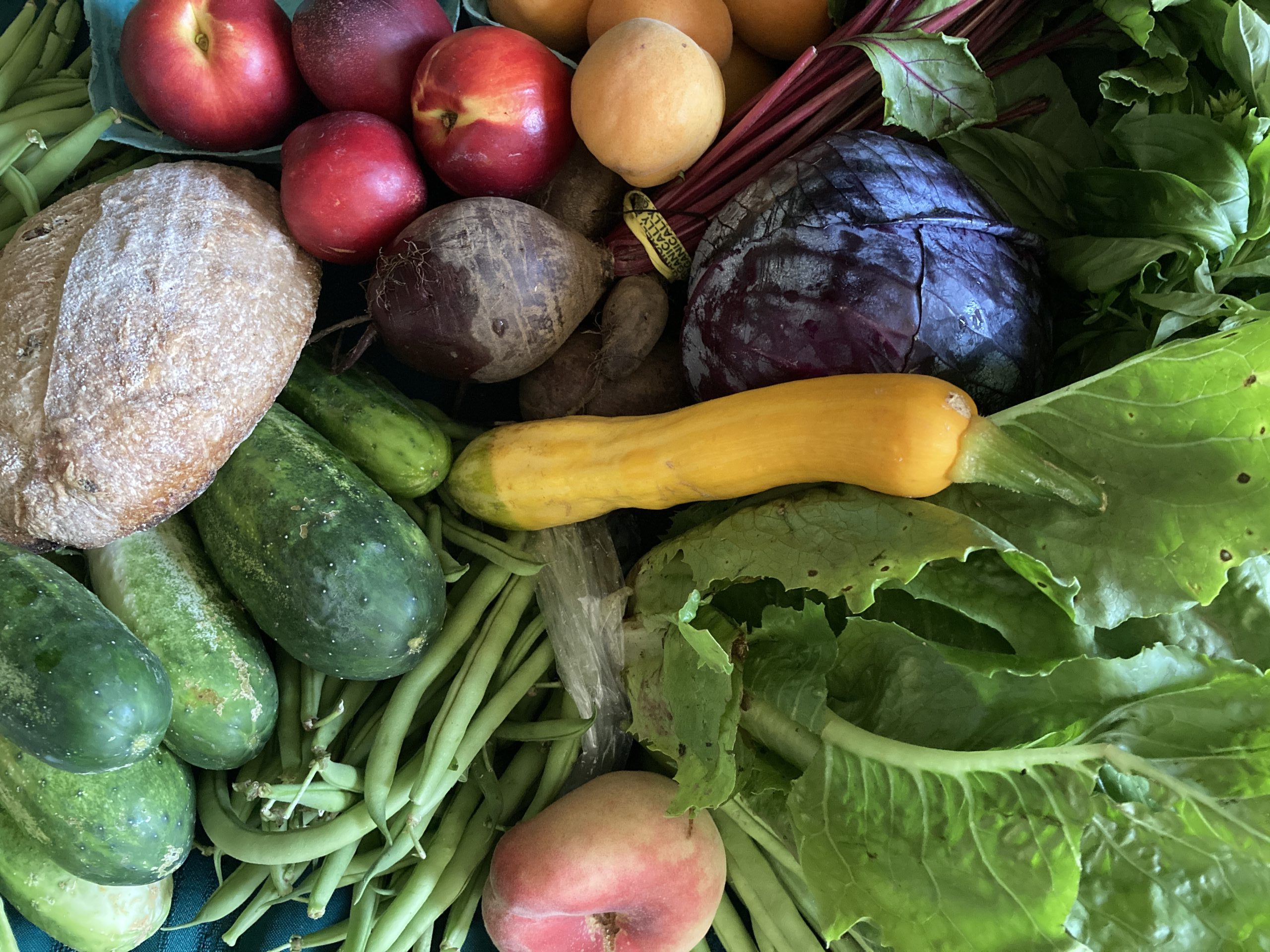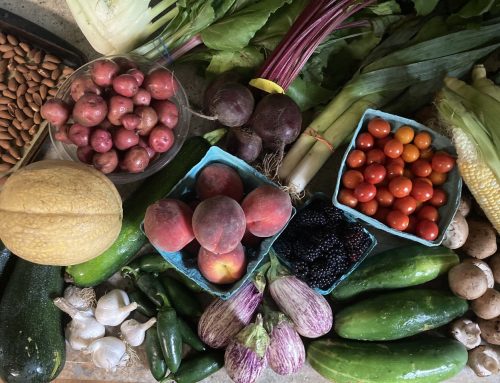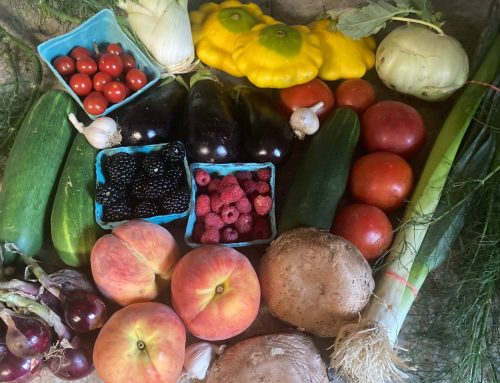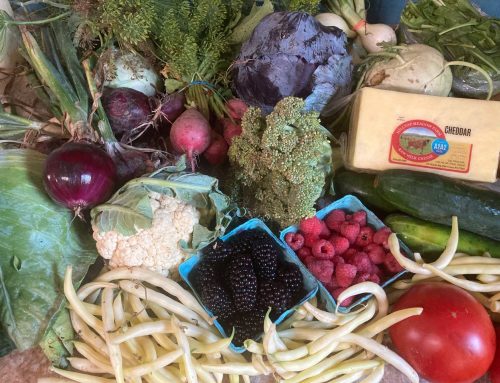Veggies We Harvested This Week: July 11, 2023
Every member’s customized Market Box is unique so we hope you will take advantage more varieties of vegetables as you get comfortable with all the great organic produce we are offering. Use our A to Z Vegetable Guide to help use and store your veggies. Storage tips and recipes below.
Storage & Usage Tips
As I unpack my vegetables from my market box I share extra tips and suggestions that you won’t want to miss.
How to tell when your peach or plum is ripe?
What kind of onions and what to do with them?
The difference between pickling and slicing cucumbers.
All this and more in my unboxing video:
What to use first: broccoli, basil, dill, lettuce, snap peas, microgreens, red raspberries,
Finished for the season: Asparagus, garlic scapes, snap peas,
Done for now but will return: Broccoli, Bok choy, Radish
Basil – store as with all herbs. Basil doesn’t like being in a bag in the fridge for very long. A fragrant basil with reminiscent of cinnamon, purple Basil can be used any way Italian basil can – even Pesto<. Purple Pesto will be unique in color but finds it's place in pasta quite easily. Store as with all herbs. Basil doesn’t like being in a bag in the fridge for very long. Green Basil is the classic italian basil for Pesto Recipes. Trim stems and place basil upright in a glass of water in the fridge or on your kitchen counter. Basil pairs well with summer squash, cucumbers, tomatoes and many others. If you cannot use the basil this week, preserve the herb by tying a string around the bunch and hanging it upside down in a well-ventilated and dry area. When it’s dry, crumble and store in an airtight container. One of my favorite salads with Basil, Cucumber and Lettuce
Beets, red – To store: If your beets still have greens attached, cut them off, leaving an inch of stem. Store the beet roots, with the rootlets (or “tails”) attached, unwashed, in a plastic bag in the crisper bin of your refrigerator. They will keep for several weeks. To prep: Just before cooking, scrub beets well and remove any scraggly leaves and rootlets. If your recipe calls for raw beets, peel them with a knife or a veggie peeler, then grate or cut them according to the recipe. To remove the skins, you can roast them in foil or boil them, and the peels will slip right off. To freeze: Boil or bake beets until done. Cool them in ice water or let them come to room temperature. Remove peels. Trim the beets into 1/4 inch slices or keep them whole (if they are small). Place in Ziplock freezer bag and remove as much air as possible. Seal and freeze. Recipes: Beets with Carmalized Onions and Feta . Make Beet Fries by peeling large beets and slice up like French fries. Toss with olive oil and spread on oiled cookie sheet. Bake at 350 deg. until tender.
Cabbage – General instructions for all types: To store: Place dry, unwashed cabbage heads in the refrigerator, preferably in the vegetable bin. To prep: Rinse the cabbage under cold water before use. Cut cabbage head in half. Be sure to remove the stem end and triangular core near the base. To use: Eat raw in salads, steamed, braised or fried. Turn raw cabbage into coleslaw or sauerkraut. Roast cabbage steaks/slices at 400 F drizzled with olive oil and salt. Or try stir-frying shredded cabbage in olive oil until wilted with a little bit of minced garlic. To freeze: Choose how to cut your heads based on your end use. Cook in boiling pot of water for 90 seconds. Douse in ice water to stop the cooking process. Drain the cabbage and dry as much as possible. Place in Ziplock freezer bags based on your portions you plan to use, and remove as much air as possible. Put in freezer.
Cabbage, green – this is a green summer cabbage, which means that it is great for any cabbage recipe but it is not meant for long term storage like fall cabbages. It is slaw season so here is another recipe, with a twist: Lime Ginger Slaw.
Cabbage, red – Make a very pretty Red Cabbage Slaw. Braised Red Cabbage or this version with apples and onions for a cooked side dish.
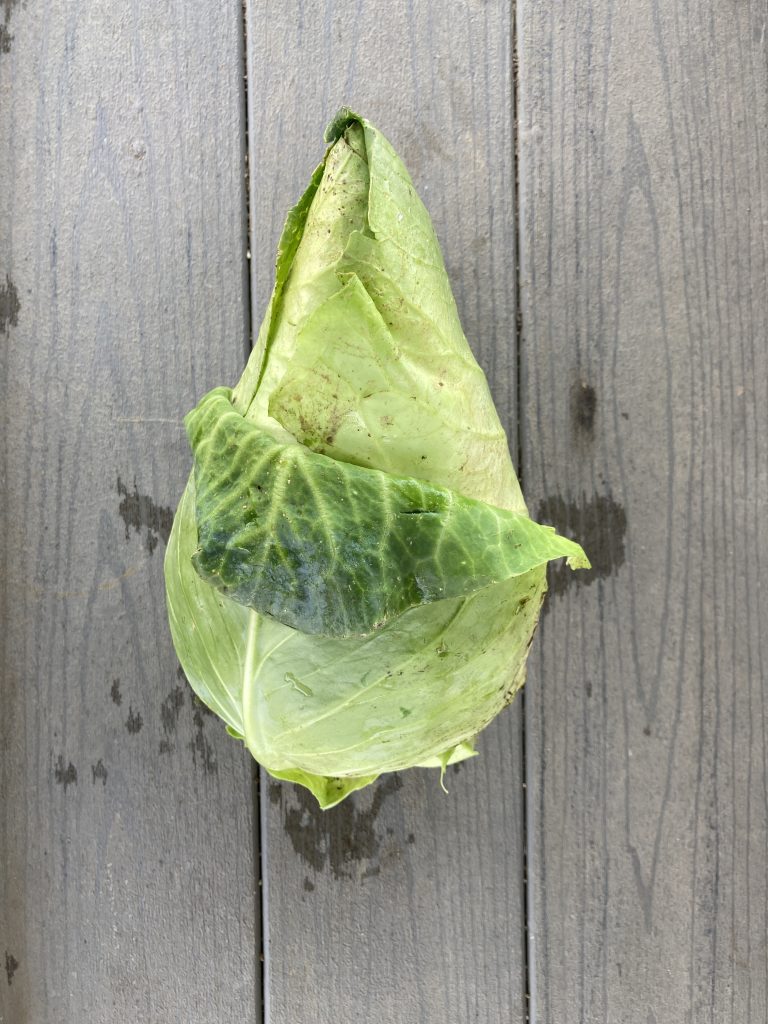
Caraflex Cabbage – also known as conehead cabbage or pointy cabbage, is a type of cabbage that has a unique, conical shape with tightly packed leaves. It is a member of the Brassica family and has a mild and slightly sweet flavor. Caraflex cabbage is a nutritious vegetable that is low in calories and high in vitamins A and C, dietary fiber, and antioxidants. It also provides minerals such as potassium and calcium. Storage: To store caraflex cabbage, keep it unwashed and dry. Place it in a perforated plastic bag or wrap it loosely in a plastic wrap to maintain its moisture. Store it in the refrigerator’s crisper drawer, where it can last for up to a week. Avoid storing caraflex cabbage near fruits or vegetables that produce ethylene gas, as this can cause it to spoil faster. Usage: Try raw in salads, slaws, or used as a crunchy addition to sandwiches or tacos. Caraflex cabbage can also be cooked by stir-frying, sautéing, roasting, or steaming. Its tender yet crisp texture makes it suitable for stir-fries, soups, stir-fried noodles, and other cooked dishes.
Special Usage: Due to its cone-like shape, caraflex cabbage is great for stuffing. The individual leaves can be filled with a variety of ingredients, such as grains, proteins, or vegetable mixtures, and then baked or steamed. The leaves can also be used as wraps for healthier and low-carb alternatives to traditional wraps or tortillas.
Chamomile – is a flowering herb to enjoy both to look at and to consume. Store in a vase as you would any flowers and change the water daily to keep fresh. The easiest and most common use is for a relaxing tea, often found in products to use before bed. Here are some ideas to get you started: Five Delicious Ways to Indulge in Fresh Chamomile. If you cannot use the chamomile this week, preserve the herb by tying a string around the bunch and hanging it upside down in a well-ventilated and dry area. When it’s dry, crumble and store in an airtight container and use it for tea.
Chinese/Napa Cabbage – Can be eaten raw in salads or cooked any way you would use traditional cabbage. It tastes excellent in Asian-flavored dishes, especially stir frys. Store the napa cabbage wrapped in a damp towel or plastic bag in crisper drawer. The napa cabbage will stay fresh for up to two weeks. Curried Macaroni and Tuna Salad with Napa Cabbage. will show you how to add Napa to any dish. Slice your Grass fed beef thin and use in a Beef and Napa Stir Fry.
Collard Greens – To store, wrap the greens, unwashed, in damp paper towels until you are ready to use them. Keep the wrapped greens in an open plastic bag in the refrigerator for up to about 5 days. When you are ready to cook the greens, you’ll need to wash them.
Have you used your collard greens to make “lettuce” wraps yet? They hold together better so they are a great substitute. Use them to make kale chips, hide them in kale brownies or add them to soups. You can even make green cubes to add them to soups and stews later. Try this slaw recipe with Collards, Cabbage and Basil.
Cucumber, Pickling – store in a loosely sealed plastic bag in the fridge. If you want to try fermenting pickles, check out my post: Easy Fermented Cucumber Pickle
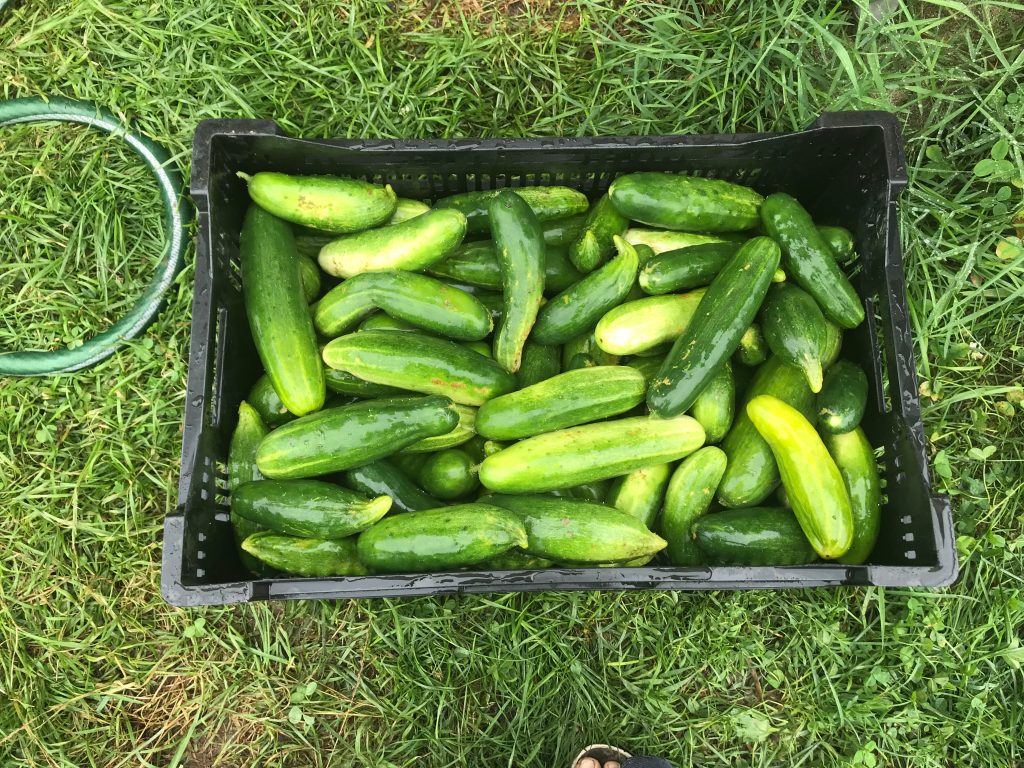
bin of pickling cucumbers
Cucumber, Slicing – store in a loosely sealed plastic bag in the fridge. Cucumber Salad is a classic!
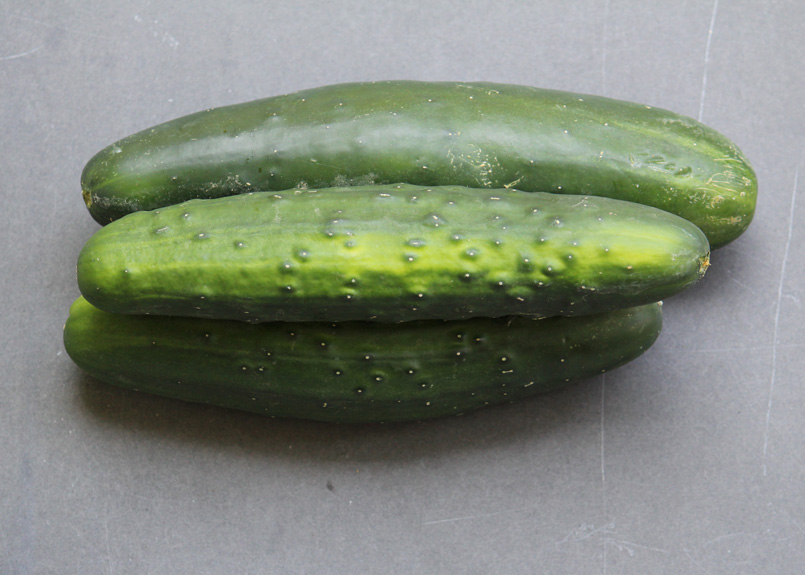
slicing cucumbers
Green Beans– Beans should be stored in a loosely sealed plastic bag for about a week in the crisper drawer. String beans are great with pesto and I love this recipe for Blistered Green Beans. Green beans are also popular for pickling. You can use the same method as described in my post about cucumber pickles.
How To Freeze Green (any color) Fresh Beans:
- Gather equipment: Large pot of water 8 quarts; strainer or colander; slotted spoon; ice water in a sink or large bowl; freezer bags or containers; permanent marker for labeling.
- Put water on to heat.
- Cut or break stem end off. Cutting off narrow tips is optional.
- Cut or break into 2 inch pieces if desired.
- Blanch for 3 -4 minutes. This means to place about 2 – 4 cups of beans in boiling water for the amount of time.
- When are they blanch? When they are bright dark green, taste slightly cooked and are still crisp.
- Remove from boiling water with a strainer or slotted spoon.
- Dip into ice water to stop the bean from cooking further.
- Remove cooled beans from water after 1 – 2 minutes and strain in colander to remove excess water.
- Fill plastic freezer bags or containers to the amount you would use for a meal. Do not over fill.
- Place in freezer, ideally, so that cold air can circulate around each bag to freeze quickly.
Kale – Lacinato or Red Russian kale. Store in a loosely sealed plastic bag in the crisper drawer for 7-10 days. Lacinato is dark green, narrow bumpy leaves. Red Russian kale has red/purple stems and a more tender, flatter leaf. To freeze, wash and chop into small pieces and place in a freezer bag.
Have you tried Kale Chips yet? Kale is a superfood but if you aren’t super fond of it try DIY Kale Pesto or hide it in Kale Brownies.
Kohlrabi – green or purple variety. Cut off leaves and store separately in a plastic bag – you can use them like kale! Most likely you will receive purple kohlrabi which is more often used as a cooked vegetable. Green varieties are very suitable raw and may be cooked as well. Store bulbs in a bag or wrap in a moist paper towel. Both parts should be stored in the vegetable drawer of the refrigerator. This post has great info and suggestions for Kohlrabi. Other CSA members have enjoyed their kohlrabi grilled, roasted and spiralized into noodles.
SNACK IDEA: Cut in slices or sticks for snacking, sprinkle with salt or serve with a dip. Some people even swear that dipping in peanut butter is their favorite way to eat them.
Lettuce, Romaine – Spring Lettuce Spring Roll sounds interesting.
Microgreens – Refrigerate immediately. Keep bag sealed. Fold down to remove most air. Put in coldest part of refrigerator. Often, a bottom shelf. Can be frozen to add later to soups and other meals. Check out Emanuel Farm Powdered Microgreens for longer term shelf life. They are a tasty, nutrient-rich boost for shakes, smoothies and meals and a great seasoning for adding flavor to dishes and dips. All our micro greens are from Emanuel Farms.
Mushroom, Portobello & Cremini: these will be out of stock for the foreseeable future. The higher ups at the mushroom farm have decided that they don’t want to sell “small orders” of mushrooms to us. If you’ve enjoyed the organic mushrooms, you can let the local Giorgio Farm know by contacting Jenn Emerich, Giorgio Fresh Company Customer Service, Phone Direct Dial: 610-916-8376, Email: jemerich@giorgiofresh.com UPDATE We are working on an arrangement with another supplier.
Rhubarb – To store rhubarb, remove any leaves and trim the ends, then place the stalks in a plastic bag and store them in the refrigerator for up to a week. Although rhubarb is a vegetable, it is often prepared like a fruit or along with fruit since, left on its own, rhubarb is extremely tart. Pie seems to be the go-to for this plant; however, rhubarb makes delicious crumbles, tarts, chutneys, and even can be sauced to add to beverages or chilled soups. Rhubarb Daiquiri , Farmer Sam’s Rhubarb Sauce, Rhubarb Streusel Bread, Oatmeal Rhubarb Pie, Roasted Rhubarb
Scallions – Green onions, or scallions, can be wrapped in damp towel or placed in plastic bag in the crisper drawer of the fridge. Chop and use raw or cooked anyway you would use a bulb onion. The whole of the green onion can be eaten, stalks and all. Try this recipe for Soft Scramble Sandwhich. It’s a perfect time to make Green Onion Pancakes w/ Spicy Soy Dipping Sauce
Summer Squash – green summer squash is often called zucchini but there are many varieties of various green and yellow that are interchangeable in recipes. Crispy Baked Zucchini Casserole
Farm Food Highlights
FRUIT:
Apricots have a sweet, slightly tart flavor. They are a good source of vitamins A and C, fiber, and potassium, and contain antioxidants like beta-carotene and lutein. Store: Let them ripen at room temperature before placing in a plastic bag or container in the refrigerator’s crisper drawer to prolong freshness. Stored properly, apricots can last up to five days. Usage: Enjoy apricots fresh, as a snack or in salads, or use them in sweet recipes like pies, tarts, cakes, and jams. Grilled or roasted apricots make a tasty side dish or dessert ingredient. They can also be used in savory dishes such as salads, sauces, or glazes. Apricots pair well with honey, cinnamon, ginger, vanilla, almonds, goat cheese, prosciutto, and fresh herbs.
Donut peaches, also known as Saturn peaches or flat peaches, are a variety of peaches with a unique flat and round shape. They have a sweet and juicy flavor, similar to traditional peaches, but with a slightly milder taste. To store donut peaches, keep them at room temperature until they reach the desired ripeness. Once ripe, they can be stored in the refrigerator to prolong their freshness. Place them in a plastic bag or container and store them in the refrigerator’s crisper drawer. Properly stored, donut peaches can last for up to five days. Usage: Donut peaches are often preferred for their unique shape and texture, which makes them perfect for slicing and adding to sandwiches, wraps, or breakfast bowls.
White Peaches are a variety of peaches known for their pale, creamy-colored flesh and sweet, floral flavor. They have a slightly less acidic taste compared to traditional yellow peaches. White peaches are a good source of vitamins A and C, dietary fiber, and antioxidants. They also provide minerals such as potassium and magnesium. Storage: To store white peaches, allow them to fully ripen at room temperature until they are slightly soft to the touch and have a fragrant aroma. Once ripe, store them in the refrigerator to slow down the ripening process and extend their shelf life. Place them in a plastic bag or container in the refrigerator’s crisper drawer. Properly stored, white peaches can last for up to five days. Usage: White peaches can be enjoyed in various ways. They are delicious when eaten fresh as a healthy snack, added to fruit salads, or used in desserts like pies, cobblers, or fruit tarts. Their sweet and delicate flavor makes them ideal for eating as-is or incorporating into smoothies, yogurt bowls, or fruit-based sauces. White peaches can also be grilled or roasted to enhance their natural sweetness and served as a dessert or alongside savory dishes like salads or grilled meats.
Shiro Plums, also known as Japanese plums or yellow plums, are a variety of plums with a bright yellow skin and sweet, juicy flesh. They have a slightly tart flavor and are known for their firm texture. Shiro plums are a good source of vitamins A and C, dietary fiber, and antioxidants. They also provide minerals like potassium and manganese. Storage: Stored the same as peaches, shiro plums can last for up to a week. Usage: Shiro plums can be eaten fresh as a healthy snack or added to fruit salads for their vibrant color and sweet-tart flavor. Shiro plums are excellent for making jams, jellies, and preserves due to their high pectin content. Shiro plums can be grilled, roasted, or baked to enhance their natural sweetness and used as a topping or filling for cakes, pastries, or other baked goods. These plums be used in sauces for meats, added to chutneys, or used as a complement to cheese platters. Shiro plums can also be dried or dehydrated for a delicious and nutritious snack.
How long do fresh peaches/plums keep?
Generally, conditioned peaches will last for 3-4 days on the counter, slightly longer in the fridge, and they can be frozen for an extended time.
- Do not place peches in the refrigerator if they are still firm.
- Leave them on your counter at room temperature until they reach your desired softness.
- For faster ripening you may place peaches in a brown paper bag on your counter.
- Once your peaches have reached your desired softness, you may place them in the refrigerator.
- In the refrigerator, peaches should last an additional week or so.
- For maximum flavor, allow peaches to warm to room temperature before eating (about 30 minutes).
Blueberries – Keep blueberries unwashed in a covered container or loosely closed plastic bag in the refrigerator. Avoid washing them until just before use to prevent moisture. Fresh blueberries can last up to a week when properly stored.
Red Raspberries – are delicious berries that belong to the rose family. They are low in calories and fat, high in dietary fiber, and rich in vitamins C and K. Raspberries are also a good source of antioxidants, including anthocyanins, which contribute to their vibrant color and may have protective effects against chronic diseases. Storage: To maximize the shelf life, remove any moldy or damaged berries before storing. Place the unwashed raspberries in a shallow container lined with paper towels to absorb excess moisture. Store them in the refrigerator and consume within a few days for optimal freshness. It is best to wash raspberries just before eating to prevent them from becoming mushy. This Vinegar Rinse is highly recommended for Raspberries: mix one part vinegar with three parts water, then gently rinse the berries in the solution. Rinse them again with plain water and pat them dry before consuming or storing.
Usage: Delicious when eaten fresh on their own as a healthy snack or added to fruit salads, yogurt, or smoothies. Raspberries can be used in baking, such as in pies, tarts, muffins, or cakes, providing a burst of flavor and a pop of color. They can also be used to make jams, jellies, sauces, or coulis. Raspberries are versatile and pair well with other fruits, dairy products like cream or ice cream, chocolate, and various herbs and spices. Their delicate texture makes them perfect for garnishing desserts or adding a touch of sweetness to savory dishes.
MEAL SUGGESTIONS:
Our members are cooking…
Farm veggie scape pesto sauce over tortellini.
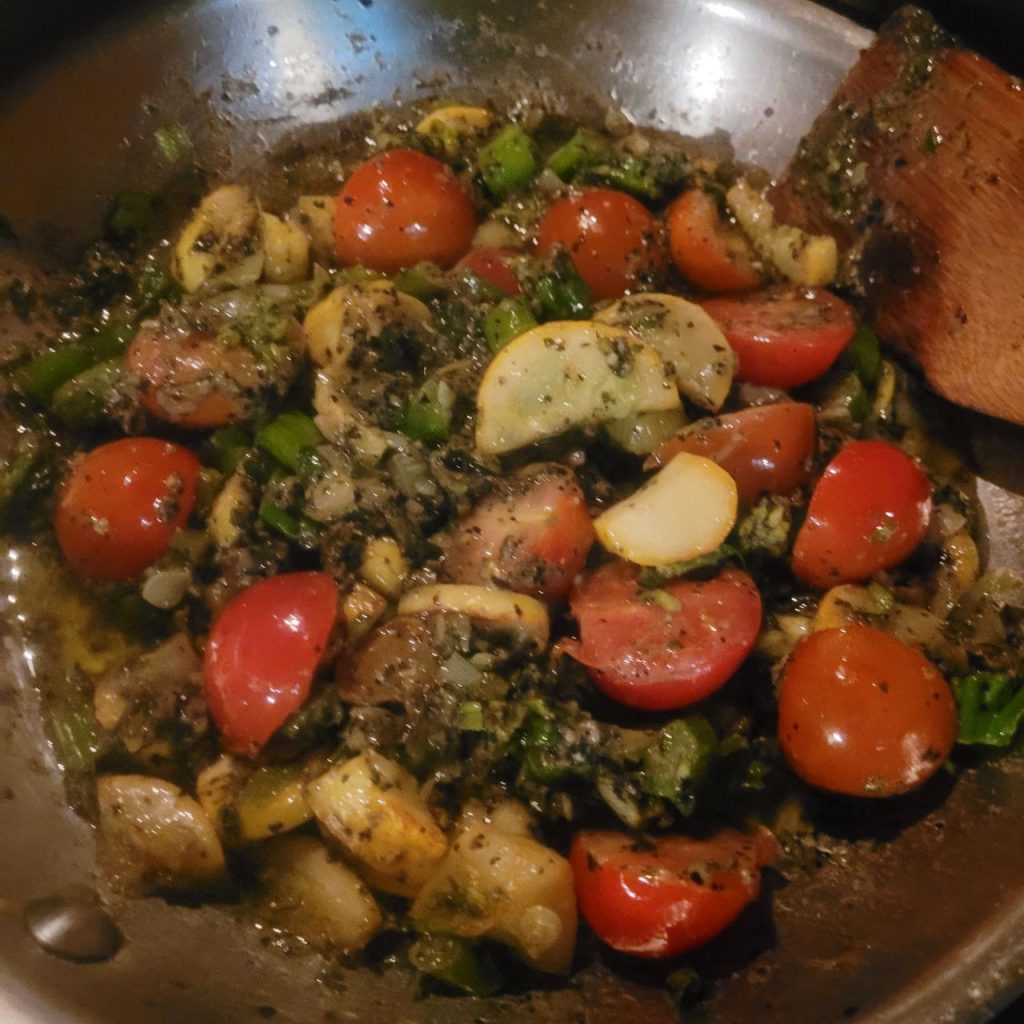
Beef Lamb sausage, broccoli and snap peas with cheese sauce with mashed potatoes.
Cashew chicken with snap peas over rice.
Sloppy Joes with farm cole slaw.
Breakfast scramble, sourdough toast with butter, farm bacon
Veggie E-Books
Download these collections of tips and recipes for each veggie. You’ll use these as a reference throughout the season.
Cucumber E-Book
Green Beans E-Book
Cabbage E-Book
Beets E-Book
Farmer Reuben’s Field Update
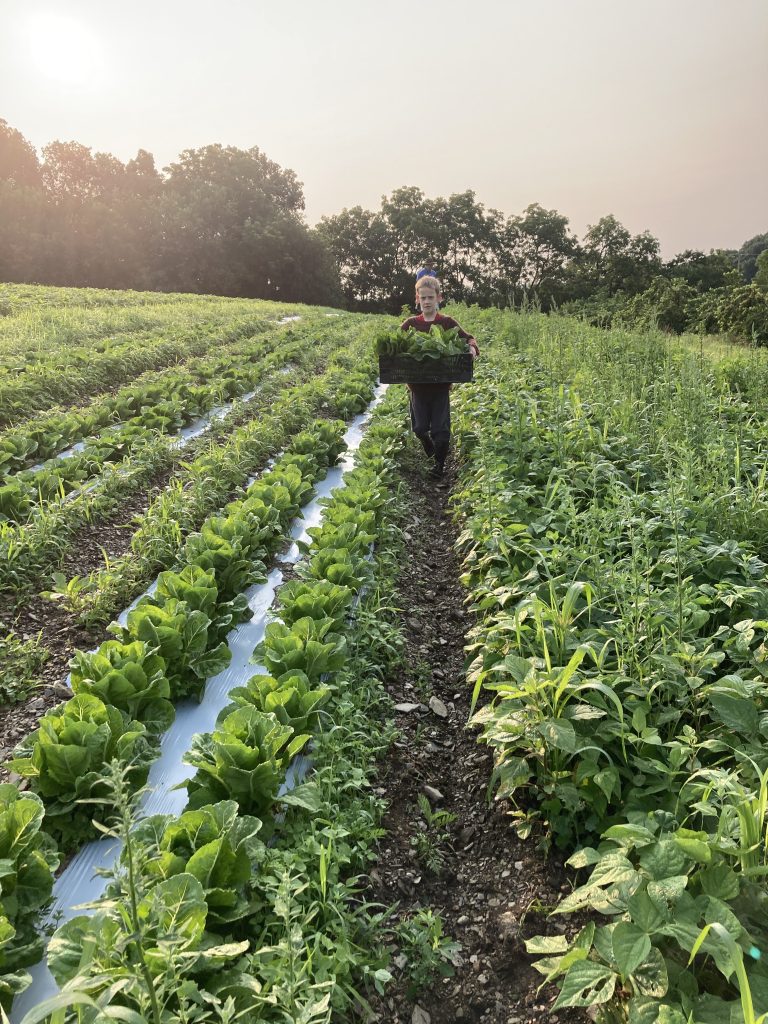
Lettuce is picked early in the morning while the dew is still on the ground. Little farmer Boy wears rubber boots to keep his feet dry.
Working directly with Dad before before breakfast is a great way to start training for farming and for life.
We’ll keep farming for you!
Reuben and Tessa DeMaster
Willow Haven Farm
Don’t Miss Your Farm Events:
Next BRICK OVEN PIZZA NIGHT
Saturday, Aug 5, 2023. 5 pm – 8 pm.
More details and reservations.
Harvest of Wisdom Homesteading Conference at Willow Haven Farm
Saturday, September 2. 8 am – 3 pm.
- morning and afternoon workshops with breakfast and lunch
- hands on workshops such as sourdough bread baking, chicken butchering
- in depth farm tours with Farmer Reuben
- organic methods for vegetable growing
- pasturing your animals
Limited space. Must register for high demand workshops. Look for Registration information soon.
Market Box Value!
Five of our Top Tips to get the most value out of your Market Box and enjoy the most food you’ll love. Read Here.
Your List of What to Return:
Please return the packaging we sent you for your last delivery. Here’s how and what exactly we’ll take back: Read Here.
We’ll Keep Farming for You!

